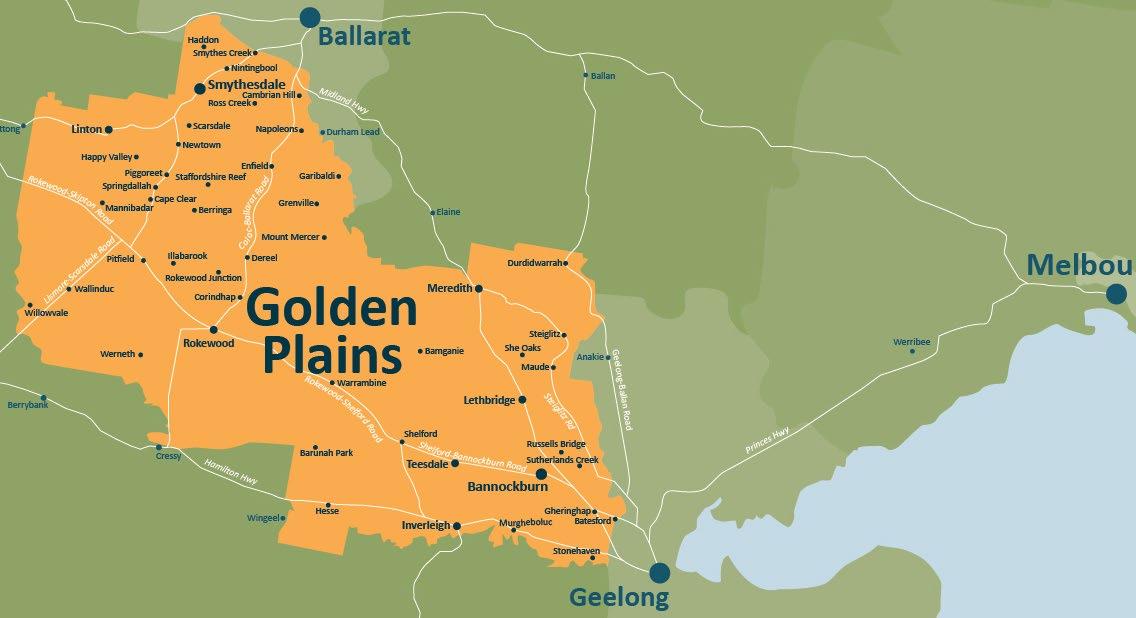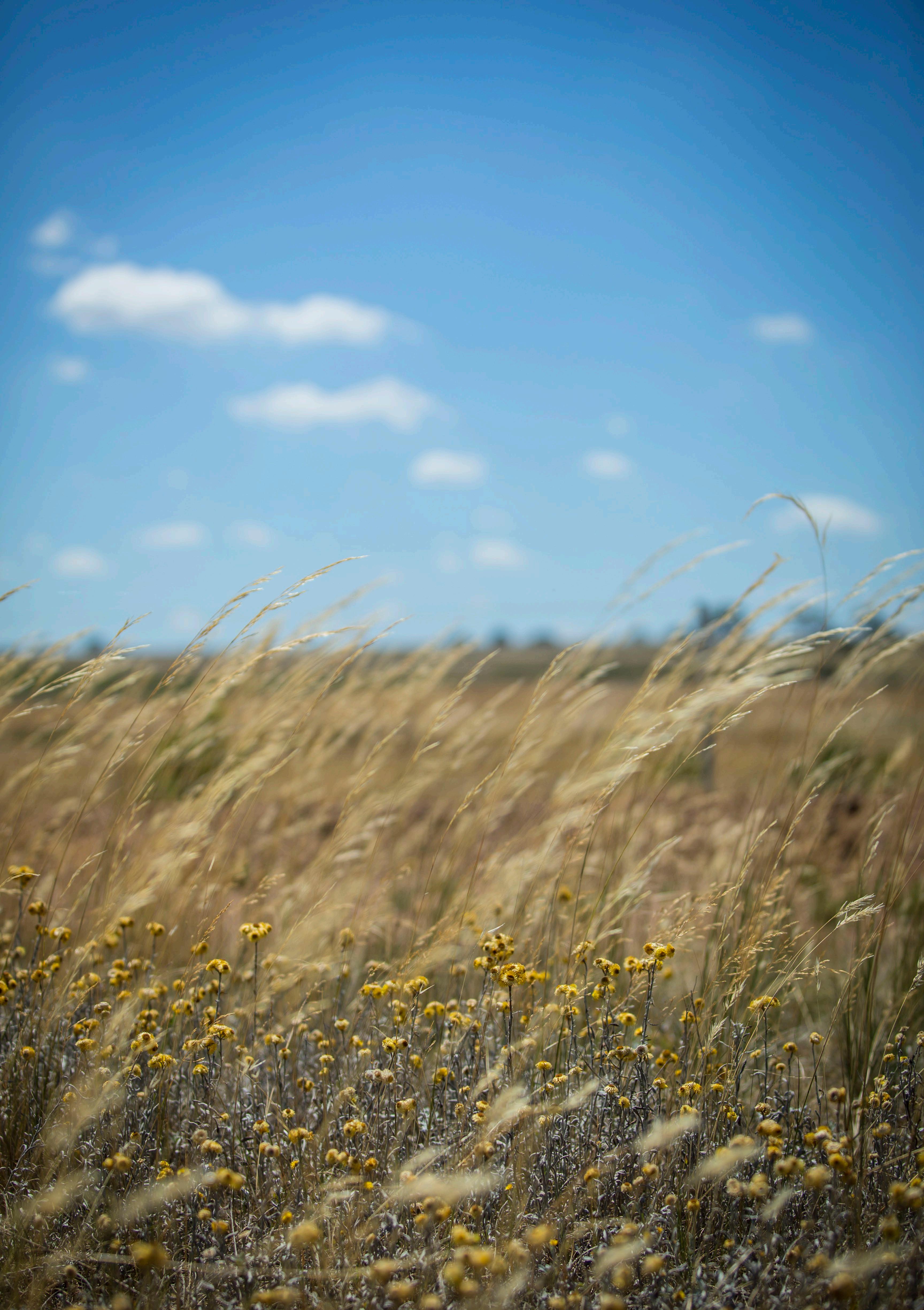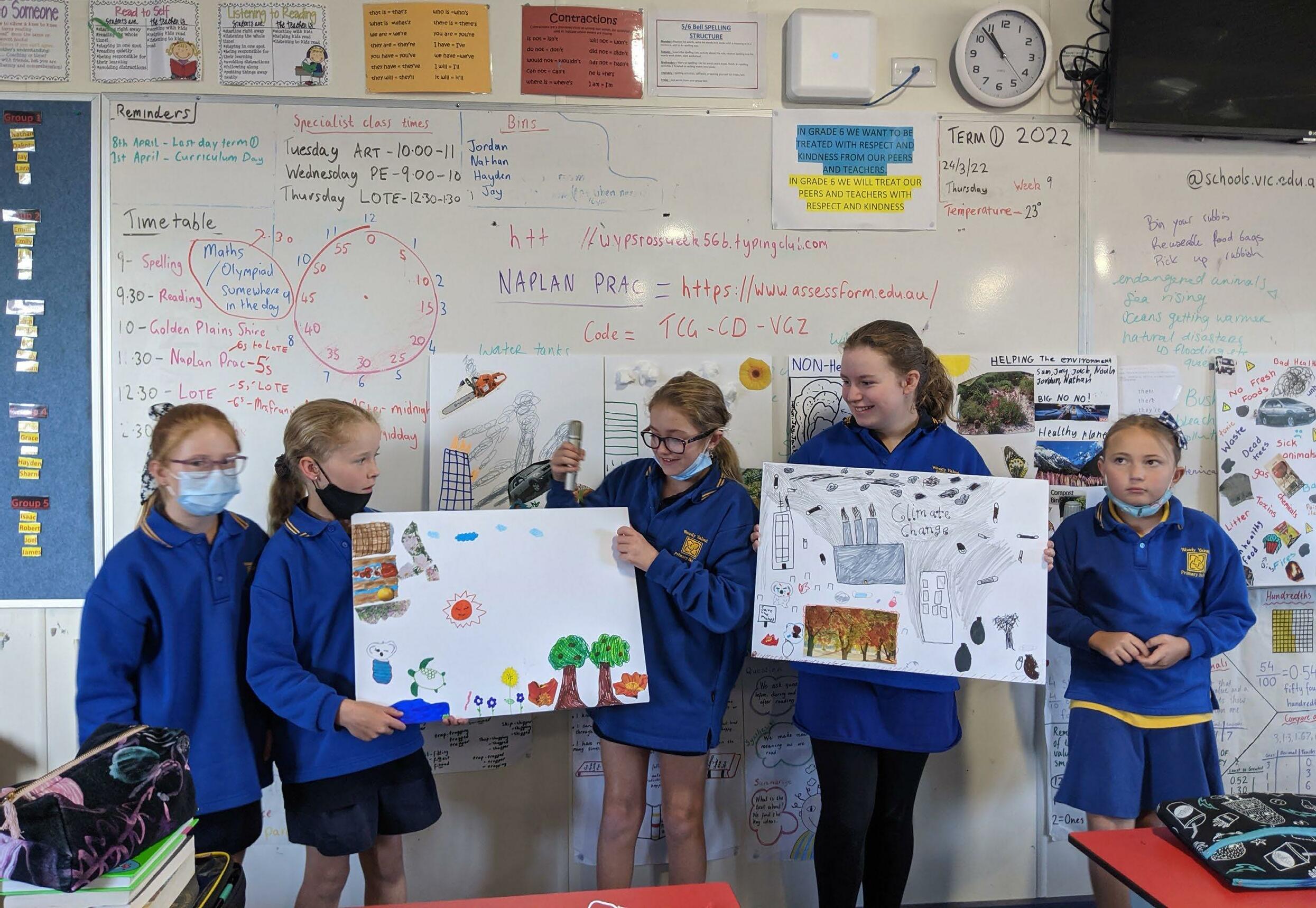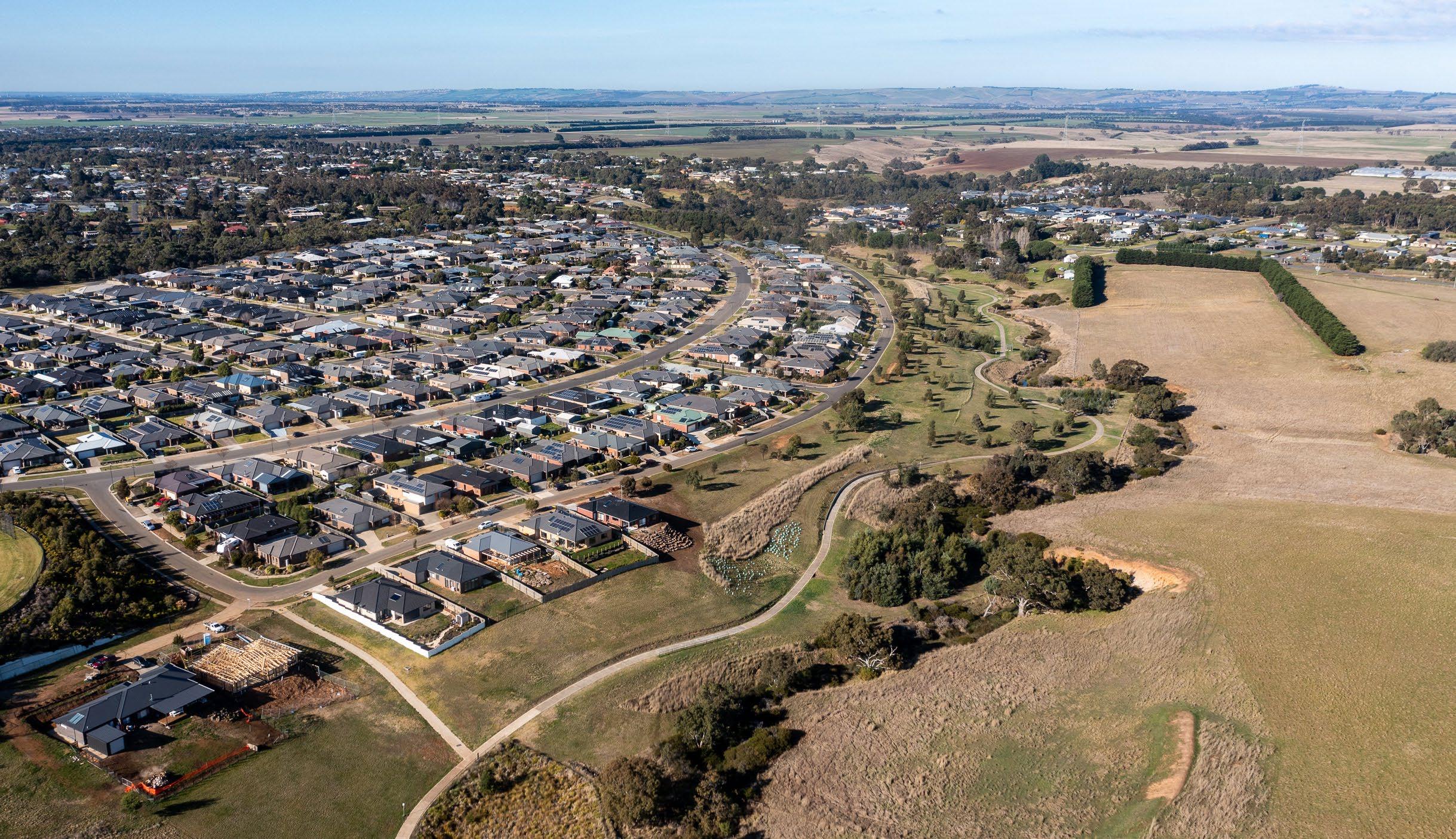
18 minute read
6. Addressing the Climate Emergency
6. ADDRESSING THE EMERGENCY
Introducing the plan
Advertisement
The following Plan outlines Council’s climate mitigation and adaptation priorities for action on climate change over the next 10 years. The Plan identifies the actions Council will take to respond to the Climate Emergency and actions Council, together with the Golden Plains Shire community, will work on to create a more sustainable future together. The implementation of the Plan requires a Council-wide response and collaboration with both the community and other organisations.
A Climate Emergency Plan is a necessity not a luxury. Strong action, foresight and unprecedented levels of collaboration across all sectors of the Shire (and beyond) is vital. The next 10 years of action are critical and this Climate Emergency Plan is an essential tool for informing our collective response.
- Golden Plains Shire community member
Actions are informed by consultation with stakeholders including the Golden Plains Shire community, businesses, and Council staff, the details of which are provided in Appendix B. Appendix C outlines how monitoring and reporting of the Plan will be undertaken. To lead action on climate change, Council will support renewable energy, facilitate sustainable transport and development, and implement adaptation focussed land management strategies. Council will also work to build understanding and resilience amongst the community and advocate for urgent and bold climate action from both State and Federal Governments.
The Plan is organised into five themes:
1. Embedding climate action into Council 2. Resilient and adaptive community 3. Caring for the land 4. Climate responsive development 5. Sustainable transport and travel Each theme and associated actions are outlined in the following sub-sections. In the Action tables, the year refers to the year in which the action will commence. Commencement years have been chosen based on current projected resourcing, but where possible will be brought forward. The fourth column, ‘mitigation/adaptation’, refers to whether the action is focussed on reducing emissions (mitigation) or helping adapt to climate change (adaptation). Some actions fall into both categories, noted as ‘both’.
Theme 1: embedding climate action in Council

Immediate action is required by all levels of society to drastically reduce emissions to mitigate the impacts of climate change. Though governments, businesses and communities are seeking to reduce the amount of greenhouse gases they emit, certain impacts of climate change are unavoidable. Therefore, Council is acting to both reduce the Shire’s contribution to climate change, and prepare for the changes the Shire is likely to experience.
- Friends of Bannockburn Bush
Actions outlined in this section include those that Council will undertake internally and those related to decreasing the footprint of Council events and Council community facilities.
What Council is already doing
• Victorian Energy Collaboration - As of May 2021, Council gets all power sourced renewably (52% of emissions). • Barwon South West Climate Alliance founding member - A collaboration of Councils, catchment management authorities, water authorities and universities in the Barwon South
West region looking to take collaborative action on climate change. Founded in October 2021. • Solar installation - Solar has been installed on Council facilities including the Golden Plains
Civic Centre in Bannockburn, the Well in Smythesdale and other smaller facilities such as community gardens, with plans to install more panels. • Municipal Health and Wellbeing Plan - Priority 5 focuses on tackling climate change and its impact on health.
embedding climate action in Council Actions
ID Action
Implementation Start year Mitigation/ Adaptation
1.1 Ensure Council climate risks are recorded and addressed
1. Review risks listed in Council risk register to ensure climate risks are listed along with appropriate mitigation strategies.
1.2 Embed climate change into Council project delivery processes
1. Include climate change considerations as a component of Council’s project management framework.
1.3 Ensure climate change mitigation and adaptation measures are taken into account in new Council building projects
1. Develop an Environmentally Sustainable Design (ESD) Policy. 2. Implement and promote Policy.
1.4 Embed climate change into Council grant processes
1. Revise weighting for assessment of Berrybank Windfarm Community Grant applications to include climate change as a consideration. 2022 Both
2022 Mitigation
2023 Both
2023 Both
1.5 Increase the energy efficiency of Council assets
1. Upgrade street lighting in the Shire to LED.
1.6 Decrease environmental impact of Council events
1. Identify emissions generated from Council events. 2. Develop policy to require all events run by Council or in collaboration with Council to be carbon neutral.
1.7 Future proof Council facilities
1. Audit all Council facilities to identify and prioritise upgrading and implementing mitigation and adaptation features by 2027. Consider which facilities can be considered climate refuges. 2. Invest in upgrading facilities on an ongoing basis. 3. Promote upgraded facilities including those that are suitable climate refuges.
1.8 Decrease water usage at Council facilities
1. Identify baseline water usage at Council facilities. 2. Explore opportunities for reducing water usage by at least 20%. 3. Implement measures to decrease water usage. 2023 Mitigation
2024 Mitigation
2024 Both
2025 Both
1.9 Identify, eliminate and reduce Council emissions wherever possible. Where eliminating or reducing emissions isn’t possible, purchase carbon offsets
1. Seek and work with partners to create and promote local and regional offset opportunities. 2025 Mitigation
ID Action
Implementation
1.10 Embed climate change into Council induction practices
1. Develop an information pack with key facts. 2. Host a quarterly session to ensure new employees are educated about Council’s climate change efforts during their induction period. 3. Require all employees to attend a session.
1.11 Increase Council staff knowledge about the Climate Emergency
1. Develop a Climate Emergency course to put up on Council’s staff learning platform. 2. Offer and promote the course.
Investigation
1.12 Decrease emissions generated by single-vehicle travel
1. Investigate a carpooling system for Council staff. 2. Promote and launch system.
Planning
1.13 Reduce emissions generated by Council fleet
1. Commission development of feasibility study to convert Council vehicles to electric. 2. Develop transition plan based on feasibility study. 3. Replace fleet based on transition plan.
1.14 Embed climate change into Council procurement processes
1. Update procurement policy to include sustainability targets. 2. Update tender applications to include sustainability criteria tailored to the type of suppliers.
1.15 Reduce Council’s Scope 3 emissions
1. Commission a report on Council divesting from fossil fuel investments. 2. Implement report.
1.16 Decrease the environmental impact of road, footpath and playground materials
1. Identify research institutions exploring use of low carbon and/or high recycled content concrete and asphalt/emulsion options. 2. Undertake benchmarking research to understand what is being done by other Councils. 3. Plan transition from current materials to new materials. 4. Implement use of new materials.
Advocacy
1.17 Advocate to the Victorian and Australian governments to declare a climate emergency and to act in accordance with climate science Start year
2029 Both
2030 Both
2027 Mitigation
2022 Mitigation
2023 Mitigation
2024 Mitigation
2025 Both
Ongoing Both
theme 2: Resilient and adaptive communities
Climate change will impact everyone in the Shire. Direct impacts include increased intensity and frequency of extreme weather events such as prolonged heatwaves, drought, floods and bushfires. Indirect impacts include worsening air quality, changes in the spread of infectious diseases, risks to food safety and drinking water quality, and effects on mental health7 .
These risks will have a greater impact on those who are already vulnerable such as older people, people with disabilities, or those in unsecure housing. Council plays a key role in educating and sharing information with residents, schools and businesses. To address the Climate Emergency, Council will use its leadership and resources to partner with the community, other Councils, Traditional Owner groups and the Barwon South West Climate Alliance to amplify community voices and undertake collective advocacy and action.
“Great spirit Bundjil told us to take care of the great life within the land. To only take what you need without selfishness. Wadawurrung shared their knowledge of singing, dance, trade, camps, fishing, hunting, paintings, and homes to us to protect for our future generations. We all need to help11 .
- Stephanie Skinner, Wadawurrung Country Plan (2020-2030), page 2
What Council is already doing
• Edible Gardens Program - Council hosts a series of webinars aimed to educate the community on how to grow food at home without the use of chemicals. • Reusable nappy workshops - Council is providing educational workshops and a set of cloth nappies for parents with babies to encourage the uptake of reusable nappies. • Community Strengthening Environment and Sustainability grant stream - Funding opportunity for community groups seeking to do environment and sustainability focussed projects. • Solar funding - Council has received $39,000 in funding to assist with installing solar panels on community facilities.
Did you know?
Heat is the most direct consequence of climate change. Heatwaves cause more deaths than any other natural hazard.
Adapt Grampians (2021-2025), Grampians Region Climate Adaptation Strategy
Did you know?
Golden Plains is one of Victoria’s premier areas for intensive agriculture with a large portion of rural land used for wool, beef, chicken, pork, lamb, eggs and grain production, as well as viticulture.
Golden Plains Shire Council Environment Strategy (2019-2027).
ID Action
Implementation
2.1 Embed climate change into Council community grant processes
1. Update assessment criteria for Community Strengthening Grant applications to require climate change as a consideration.
Start year Mitigation/ Adaptation
2022 Both
2.2 Increase the community’s knowledge about climate change through art
1. Identify community-led climate focused art projects (for example, working with GPArts Inc.). 2. Collaborate with the community to deliver art projects.
2.3 Embed climate change into Council programming
1. Present Council’s Climate Emergency Plan during each Community Leadership Program. 2. Include tackling climate change and its impact on health as a criteria in the Community Leadership program project development process.
2.4 Identify opportunities for improving Farmers Market practices
1. Assist in audit process to identify opportunities for sustainable practices. 2. Develop sustainability guidelines for stallholders at Council run markets. 3. Incorporate findings from audit into future planning processes, dissiminate guidelines to stallholders and provide ongoing support.
2.5 Increase the number of mitigation and adaptation focused projects undertaken by community in the Shire
1. Plan resourcing and application guidelines for the establishment of a Climate Emergency stream in the Community Strengthening Grants program. 2. Establish the new grant stream.
2.6 Assist schools to embed sustainability into their practices
1. Promote and support schools to sign up to become a Resource Smart school through Sustainability Victoria. 2023 Adaptation
2023 Both
2025 Both
2025 Both
2026 Both
2.7 Increase the community’s ability and knowledge to grow their own food
1. Identify areas for new or expanded community gardens. 2. Expand community gardens and educate residents about growing food. 2026 Both
2.8 Decrease the environmental footprint of community facilities
1. Offer free sustainability audits for community facilities not falling within Council’s remit. 2. Support implementation of upgrades (for example, support applying for grants, exploring bulk buy opportunities, fund matching).
2.9 Embed climate change into community project processes
1. Update the assessment criteria for community seed funding applications to require climate change as a consideration. 2. Review and update the Community Coordinator toolkit to embed climate change information. 3. Provide education to Community Coordinators about how climate change may impact their community. 4. Offer community education and capacity building initiatives. 2027 Both
2027 Both
ID Action
Collaboration
2.10 Increase the community’s knowledge about solar and battery storage
1. Facilitate access to expert advice on solar and battery storage for Golden Plains Shire businesses and residents.
2.11 Increase student engagement with the natural environment
1. Develop a planting fund for all primary schools to plant annually on school or public land. 2. Promote the funding opportunity to schools. 3. Follow up with schools to monitor progress via survey, photos and conversations with teachers.
Investigation
2.12 Increase business understanding of climate change and increase their capacity to reduce their emissions and adapt
1. Develop and disseminate a survey for businesses to understand their current sustainability efforts and where support is needed. 2. Analyse results from business survey to identify what support can be provided. 3. Develop and deliver programs to support businesses.
2.13 Improve comfort, reduce energy bills, build climate resilience and improve health outcomes for vulnerable households in the Shire
1. Explore opportunities for building upgrades for vulnerable households including those of older people and people on low incomes. 2. Support implementation of upgrades.
2.14 Increase agricultural business capacity to reduce their emissions and adapt
1. Investigate how Council can best support agricultural businesses to respond to the climate emergency. 2. Develop plan to support agricultural businesses. 3. Deliver plan.
Start year Mitigation/ Adaptation
2027 Mitigation
2027 Mitigation
2022 Both
2024 Mitigation
2025 Both
2.15 Increase students’ knowledge of local food and their ability to grow their own food
1. Investigate options for students to grow their own food (for example, through the Stephanie Alexander Kitchen Garden Foundation). 2. Secure partnership and select schools to participate. 3. Oversee delivery of program.
2.16 Explore implementation of community driven renewable energy in Golden Plains Shire to reduce reliance on fossil fuels
1. Undertake research to better understand steps, costs and other resources required. 2027 Mitigation
2.17 Explore ways to promote efficient resource use in the Shire
1. Investigate feasibility and locations for expanding repair cafes and other spaces that are designed for shared use of resources such as toys, garden tools etc. 2026 Both
2029 Mitigation
Tree planting at Bruce’s Creek Reserve, Bannockburn
Did you know?

Community energy projects are those in which a community comes together to develop, deliver and benefit from sustainable energy. They can involve energy supply projects such as renewable energy installations and storage, and energy reduction projects such as energy efficiency and demand management. Community energy can even include community-based approaches to selling or distributing energy.
THEME 3: caring for the land
Golden Plains is comprised of two distinct environments or bioregions: the Central Victoria Uplands and the Victorian Volcanic Plains. These bioregions support 372 flora species and 191 fauna species and include three major river systems. Most of the land in the Shire is defined as ‘bushfire prone’.
Traditional Owners and Custodians are the first people to care for the land, cultivated through a deep sense of respect for natural resources. However, changes to temperature, rainfall, storm and fire patterns due to climate change will put species and ecosystems at risk8 . Harsher fire weather and longer fire seasons will also put people and infrastructure in jeopardy.
The preservation of biodiversity and enhancement of environmental resilience is of vital importance for the function of ecosystems, persistence of wildlife and community safety. Council’s efforts through this focus area include working to increase the resilience of communities, species and ecosystems.
- Eastern Maar Country Plan (2015)
Relevant threats to Wadawurrung:
1. Urban development 2. Lack of coordination between land managers 3. Bushfires 4. Drought 5. Weeds
6. Rabbits
Did you know?
Victorian Volcanic Grasslands used to cover much of Wadawurrung Country. The central plains were covered in vast open areas of grasslands with small patches of woodlands. They are classified as a threatened ecological community. Plants
• Kangaroo grass • Wallaby grasses • Spear grasses • River gums
Animals
• Yarra Pygmy Perch • Plains Wanderer • Striped Legless Lizard
Wadawurrung Country Plan (2020-2032), page 2.
8Impacts of Climate Change, South West Climate Change portal, viewed 17 May 2022 www.swclimatechange.com.au/cb_pages/ environmental_impacts.php.
What Council is already doing
• Tree planting • Council has planted more than 10,000 native trees, shrubs and grasses over the last three years with future planting scheduled to restore biodiversity and repair damaged ecosystems. • Council will participate and support the National Tree Planting day by hosting events and supporting local community groups to undertake their own National Tree Planting event. • Council is is seeking to implement a street tree planting program, targeting vacant nature strips within townships across the Shire. • Pest, plant and animals - Council manages pest, plant and animals throughout its reserve network and implements the Rabbit Management Strategy 2021-2031. • Fire regeneration - Council has facilitated the return of Traditional Owner use of fire to
Council reserves as well as undertaking low intensity, low risk ecological burns with their own burn team to support native flora regeneration and reduce fire risk in key locations.
caring for the land Actions
ID Action
Implementation
3.1 Restore biodiversity and repair damaged ecosystems
1. Consult with Wadawurrung and Eastern Maar for natural resource management advice and opportunities where possible 2. Develop a revegetation plan for Council reserves. 3. Plant a tree for every resident in the Shire. 2025 Both
3.2 Support native flora regeneration and reduce fire risk in key locations
1. Develop a planned burn strategy, incorporating ecological and cultural burning practices requirements and that burns be led by Wadawurrung Traditional Owners where possible. 2. Implement strategy.
3.3 Improve outcomes for the natural environment
1. Deliver against the Regional Catchment Strategy and partner with the Corangamite Catchment Management Authority on land and water management projects including both broad scale management projects and community projects.
Collaboration
3.4 Ensure a healthy and resilient natural environment
1. Continue working with Traditional Owners to embed traditional knowledge and practices into Council’s land management practices.
3.5 Build working relationships with Traditional Owner natural resource management resources for on-ground works, revegetation, fire management and other climate change initiatives Start year Mitigation/ Adaptation
2027 Adaptation
Ongoing Adaptation
Ongoing Both
Ongoing Both
THEME 4: Climate responsive development

Council is responsible for implementing the Victorian Planning Provisions at the local level and prepares and adopts the Municipal Planning Strategy. Council also controls the materials that are used in the facilities it builds and for local infrastructure such as roads, footpaths and other assets.
However, many materials commonly used in the construction of buildings and infrastructure have high embedded carbon emissions. In addition, despite current energy standards and Planning Scheme provisions, most existing Victorian houses perform to low energy standards. With low or zero carbon, recycled content materials and efficient alternatives becoming more available, there is significant opportunity for climate responsive development across the municipality. Improving building development and operations reduces emissions and increases comfort and affordability in the long term. Given the number of buildings and expanse of infrastructure that Council builds, owns, manages or influences, Council will take action to lead by example and advocate for change. Council will also support owners, occupiers and landlords to take steps to implement climate friendly features on their property. Relevant threats 7. Urban development to Wadawurrung: 8. Bushfires
Did you know?
Golden Plains Shire is growing quickly with the population estimated to increase to 42,193 people by 2041, serving an important role in the growth of metropolitan Melbourne.
Adapt Grampians (2021-2025), Grampians Region Climate Adaptation Strategy
What Council is already doing
• Strategic Bushfire Risk Assessment - Council commissioned an assessment of bushfire hazard to inform a Shire-wide Settlement Plan. • Planning Scheme Review - To identify opportunities to enhance the effectiveness and efficiency of the Planning Scheme. • Integrated water management - Council works as part of two integrated water management forums to look for improved ways to manage water across the Shire. • Green Blue Infrastructure - Council led the development of a guide for Green Blue Infrastructure for small towns. The guide will be used to help Council install infrastructure that’s both waster sensitive and adapted to future climate conditions.
Climate responsive development actions
ID Action
Implementation
4.1 Address impacts of climate change, urbanisation and other water challenges at the regional and local level
1. Identify at least three opportunities for implementing integrated water management projects across the Shire. 2. Implement projects. 3. Support Traditional Owners’ ‘water is life’ roadmap.
4.2 Decrease the environmental impact of new developments in the Shire
1. Investigate options to update the Planning Scheme and Infrastructure Design Manual to include climate change related minimum standards. 2. Engage with Council and community around potential updates. 3. Develop Plan to include relevant changes.
Collaboration
4.3 Support landholders in the Shire to mitigate and adapt to climate change
1. Connect landholders to information and opportunities to implement climate friendly features on their property (for example, renewable energy, regenerative agriculture, grey water tanks, biodiversity protection, sustainable heating or cooling). 2. Investigate incentive opportunities (for example, reduced rates) for having climate friendly features on a property. Ongoing Both
Advocacy
4.4 Advocate for stronger sustainability requirements in legislation
1. Collaborate with the Barwon South West Climate Alliance to advocate to the Victorian Government to strengthen its response to climate change by strengthening environmentally sustainable design requirements in the Victorian Planning Scheme to include measures such as zero carbon building standards, green infrastructure, tree protection and ecological connectivity, sustainable transport, electric vehicle charging infrastructure. Ongoing Both
Start year Mitigation/ Adaptation
2024 Adaptation
2024 Both
Community engagement at the Golden Plains Youth Hub

THEME 5: Sustainable transport and travel
Council plays a significant role in planning local transport networks, impacting the transport choices made by the community each day.
However, the number of residents that live near public transport in Golden Plains Shire is significantly lower than the State average. There is also currently no electric vehicle (EV) infrastructure and there is a need for streetscapes and infrastructure that support safe walking and cycling. As part of this Climate Emergency response, Council will work to reduce barriers to making climate friendly travel choices through improving infrastructure, increasing education and advocating for funding for upgrades to infrastructure.






